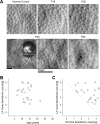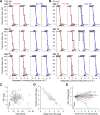Retinal Degeneration Associated With Biallelic RDH12 Variants: Longitudinal Evaluation of Retinal Structure and Visual Function in Pediatric Patients
- PMID: 39693083
- PMCID: PMC11668355
- DOI: 10.1167/iovs.65.14.30
Retinal Degeneration Associated With Biallelic RDH12 Variants: Longitudinal Evaluation of Retinal Structure and Visual Function in Pediatric Patients
Abstract
Purpose: The purpose of this study was to determine the natural history of the photoreceptor disease in a large group of pediatric patients with RHD12-associated Leber congenital amaurosis (RDH12-LCA), to estimate the changes expected over the duration of a clinical trial, and to define the relationship between the photoreceptor loss and visual dysfunction.
Methods: Forty-six patients representing 36 families were included. The great majority of patients were under the age of 18 years. Patients underwent complete ophthalmic examinations and imaging with various modalities including adaptive optics scanning laser ophthalmoscopy. Visual function was assessed with static and kinetic perimetry, and full-field stimulus test (FST) under dark- and light-adapted conditions.
Results: Patients had a severe and early onset retinal degeneration (EORD). Visual acuity losses showed a progression rate of 0.04 logMAR per year. A small foveal island could be retained but showed degeneration over time. Foveal cone sensitivity losses were predictable by the loss of photoreceptors. Peripapillary retina could be retained with no significant progression detectable. Peripapillary rod sensitivity was substantially less than expected from photoreceptor structure pointing to a large improvement potential. FST sensitivities were reliably recordable in pediatric patients and showed a small but significant improvement with age. Locally and globally, loss of rod sensitivity tended to be larger than loss of cone sensitivity.
Conclusions: Foveal cones of RDH12-LCA should be targeted with treatments aimed to slow progression, whereas peripapillary rod photoreceptors should be targeted with treatments aimed to improve night vision. Pediatric FST testing may be complicated by age-related maturation of decision making regarding threshold criteria.
Conflict of interest statement
Disclosure:
Figures







References
-
- den Hollander AI, Roepman R, Koenekoop RK, Cremers FPM.. Leber congenital amaurosis: genes, proteins and disease mechanisms. Prog Retin Eye Res. 2008; 27: 391–419. - PubMed
MeSH terms
Substances
Grants and funding
LinkOut - more resources
Full Text Sources
Research Materials
Miscellaneous

